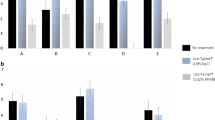Abstract
Catheter-associated urinary tract infections account for 80% of hospital-related urinary tract infections. Attempts are being made to improvise catheters to reduce the infective burden. A non-randomized clinical trial was conducted on two hundred and forty patients who required catheterization. The aim was to assess the efficacy of silver ion–impregnated Foley catheters in reducing urinary tract infections. They were divided equally with 120 patients in each group. The control group received standard Foley catheter insertion and patients in the study group received in-house-prepared silver ion–impregnated catheters. Urine was examined for the presence of pus cells on days 1, 3, and 7. Culture and sensitivity were carried out on days 1, 3, and 7. Though the initial results were similar in both groups, there was a significant reduction in the number of pus cells in urine and a decrease in positive cultures on day 7 (P = 0.0277 and P = 0.0497), respectively suggesting the efficacy of silver ion impregnation. This is a simple and easy-to-perform technique with potential for routine use in the future with adequate validation. Routine use minimizes antibiotic usage due to reduced incidence of urinary tract infections and hospital expenses.



Similar content being viewed by others
References
CDC. National Healthcare Safety Network (NHSN)- Patient Safety Component Manual. Jan 2020. Available at: https://www.cdc.gov/nhsn/pdfs/pscmanual/pcsmanual_current.pdf. Accessed 16 Nov 2020.
Monegro AF, Regunath H (2018) Hospital acquired infections [Internet]. StatPearls [Internet]. U.S. National Library of Medicine. Available at: https://www.ncbi.nlm.nih.gov/books/NBK441857/. Accessed 18 Dec 2020
Sangamithra V, Sneka, Praveen Shabana and Manonmoney. Incidence of catheter associated urinary tract infection in medical ICU in a tertiary care hospital. Int J Curr Microbiol App Sci 2017; 6:662–669
Nandkumar AM, Ranjit MC, Pradeep Kumar SS, Hari PR, Ramesh P, Sreenivasan K (2010) Antimicrobial silver oxide incorporated urinary catheters for infection resistance. Trends Biomater Artif Organs 24:156–164
William Rl, Doherty PJ, Venice DG Grasgoff GJ, Williams DF. Biocompatibility of silver. Critical reviews in Biocompatibility. 1989; 5: 221 – 223
Chung PH, Wong CW, Lai CK, Siu HK, Tsang DN, Yeung KY et al (2017) A prospective interventional study to examine the effect of a silver alloy and hydrogel-coated catheter on the incidence of catheter-associated urinary tract infection. Hong Kong Med J 23:239–245
Riley DK, Classen DC, Stevens LE, Burke JP (1995) A large randomized clinical trial of a silver-impregnated urinary catheter: lack of efficacy and staphylococcal super-infection. Am J Med 98:349–356
[INTERNET] https://www.shopcatheters.com/p-kendall-two-way-dover-silver-coated-100-percent-silicone-foley-catheter-with-30cc-balloon.html. Accessed 20 Dec 2020
Pérez E, Uyan B, Dzubay DP et al (2017) Catheter-associated urinary tract infections: challenges and opportunities for the application of systems engineering. Health Syst 6:68–76. https://doi.org/10.1057/s41306-016-0017-0
Saint S, Elmore JG, Sullivan SD, Emerson SS, Koepsell TD (1998) The efficacy of silver alloy-coated urinary catheters in preventing urinary tract infection: a meta-analysis. Am J Med 105:236–241
Platt R, Polk BF, Murdock B, Rosner B (1982) Mortality associated with nosocomial urinary tract infection. N Engl J Med 307:637–642
An YH, Friedman RJ (1998) Concise review of mechanisms of bacterial adhesion to biomaterial surfaces. J Biomed Mater Res (Appl Biomater) 43:338–348
Karchmer TB, Giannetta ET, Muto CA, Strain BA, Farr BM (2000) A randomized crossover study of silver-coated urinary catheters in hospitalized patients. Arch Intern Med 160:3294–3298
Trooskin S.Z, Donetz AP et al. Prevention of catheter sepsis by antibiotic bonding. Surgery 1985; 547–551.
Van de Belt H, Neut D, Uges DRA, Schenk W, Van Horn JR (2000) Surface roughness, porosity and wettability of gentamicin loaded bone cements and their antibiotic release”. Biomaterials 21:1981–87
Beattie M (2011) Taylor J Silver alloy vs uncoated urinary catheters : a systematic review of the literature. J Clin Nurs 20(15–16):2098–2108. https://doi.org/10.1111/j.1365-2702.2010.03561.x
Author information
Authors and Affiliations
Corresponding author
Ethics declarations
Conflict of Interest
The authors declare no competing interests.
Additional information
Publisher's note
Springer Nature remains neutral with regard to jurisdictional claims in published maps and institutional affiliations.
Rights and permissions
About this article
Cite this article
Vallabha, T., Ammanna, H., Sindgikar, V. et al. Non-randomized Clinical Trial of In-house Silver-Coated Foley’s Catheter Reduces Urinary Tract Infections—a Low-Cost Innovation. Indian J Surg 84, 818–823 (2022). https://doi.org/10.1007/s12262-021-03027-2
Received:
Accepted:
Published:
Issue Date:
DOI: https://doi.org/10.1007/s12262-021-03027-2




